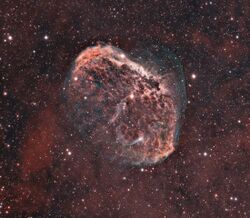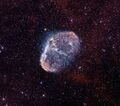Astronomy:Crescent Nebula
| Emission nebula | |
|---|---|
 The Crescent Nebula, as taken by an amateur astronomer | |
| Observation data: J2000.0 epoch | |
| Right ascension | 20h 12m 7s[1] |
| Declination | +38° 21.3′[1] |
| Distance | 5,000 ly |
| Apparent magnitude (V) | +7.4 |
| Apparent dimensions (V) | 18′ × 12′ |
| Constellation | Cygnus |
| Designations | NGC 6888,[1] Sharpless 105, Caldwell 27 |
The Crescent Nebula (also known as NGC 6888, Caldwell 27, Sharpless 105) is an emission nebula in the constellation Cygnus, about 5000 light-years away from Earth. It was discovered by William Herschel in 1792.[2] It is formed by the fast stellar wind from the Wolf-Rayet star WR 136 (HD 192163) colliding with and energizing the slower moving wind ejected by the star when it became a red giant around 250,000[3] to 400,000[citation needed] years ago. The result of the collision is a shell and two shock waves, one moving outward and one moving inward. The inward moving shock wave heats the stellar wind to X-ray-emitting temperatures.
The Crescent Nebula is a rather small object located about 2 degrees Southwest of Sadr. While considered bright by astronomical imaging standards, visually it is relatively faint. For most telescopes it requires a UHC or OIII filter to see. Under favorable circumstances a telescope as small as 8 cm (with filter) can see its nebulosity. Larger telescopes (20 cm or more) reveal the crescent or a Euro sign shape which makes some to call it the "Euro sign nebula".
Image of NGC 6888 using H-alpha filter.
Picture of NGC 6888 captured in narrowband by amateur astronomer Luca Moretti
See also
- Cygnus Bubble
References
- ↑ 1.0 1.1 1.2 "NGC 6888". SIMBAD. Centre de données astronomiques de Strasbourg. http://simbad.u-strasbg.fr/simbad/sim-basic?Ident=NGC+6888.
- ↑ Erdmann, Robert. "NGC 6888". The NGC/IC Project. http://www.ngcicproject.org/ngcicdb.asp.
- ↑ "WR 136". http://jumk.de/astronomie/big-stars/wr-136.shtml.
External links
- "Crescent". National Optical Astronomy Observatory. http://www.noao.edu/image_gallery/html/im0834.html.
- "Crescent Nebula: Live Fast, Blow Hard and Die Young". Chandra X-Ray Observatory. 14 October 2003. http://chandra.harvard.edu/photo/2003/ngc6888/.
- Crescent Nebula on WikiSky: DSS2, SDSS, GALEX, IRAS, Hydrogen α, X-Ray, Astrophoto, Sky Map, Articles and images
- Nemiroff, R.; Bonnell, J., eds (11 November 2007). "NGC 6888: The Crescent Nebula". Astronomy Picture of the Day. NASA. https://apod.nasa.gov/apod/ap071111.html.
 |






